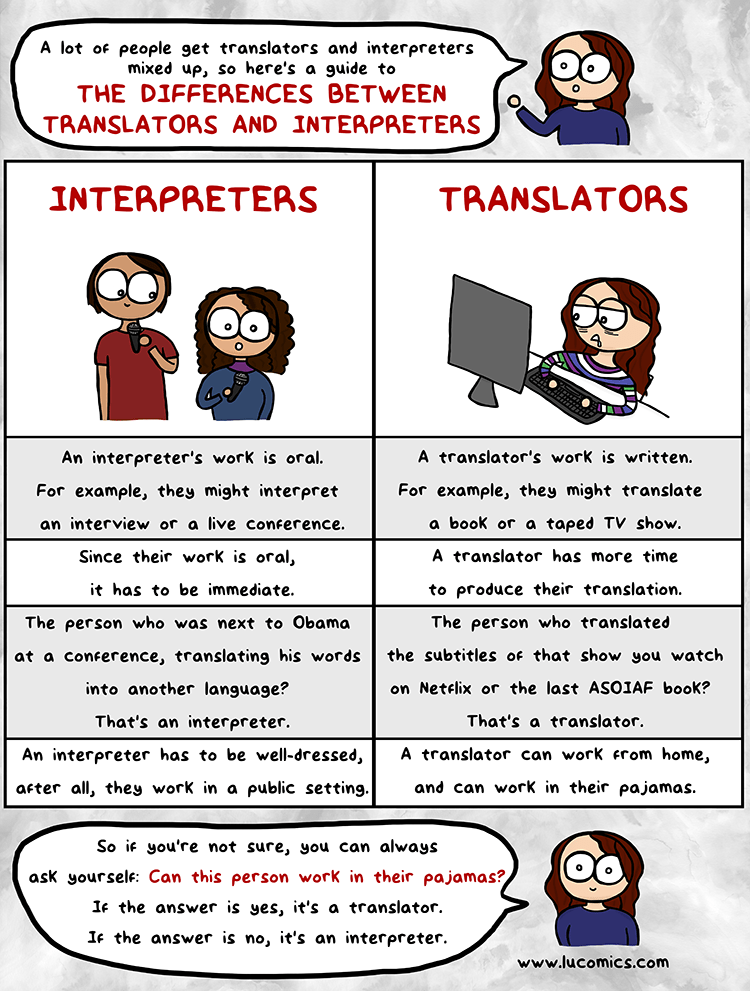So You Want to be a Freelance Translator or Interpreter: How is the T&I Industry Laid Out?
How is the T&I industry laid out?
 As a preface, I can think of numerous times since I began working as a translator that friends and family have come to me with questions about my work. Do I actually have a job? Do people pay me to do it? Who do I work for? The questions are not always this blatant, but I can often sense the underlying question of how the translation and interpreting industry really works, and whether it is a viable career for someone who knows a second language. In short, the answer is yes!
As a preface, I can think of numerous times since I began working as a translator that friends and family have come to me with questions about my work. Do I actually have a job? Do people pay me to do it? Who do I work for? The questions are not always this blatant, but I can often sense the underlying question of how the translation and interpreting industry really works, and whether it is a viable career for someone who knows a second language. In short, the answer is yes!
The question of how our industry is laid out is usually one that people do not ask straight-out, but it is the first topic I address in my response. It is crucial to have this foundational knowledge before you consider becoming a translator or an interpreter so you can decide if you—your lifestyle, your skills, your background—will make a good fit for the industry, and vice versa.
Translation vs. interpreting
The first distinction to make is the difference between translation and interpreting. Check out the infographic below to get an idea (credit: lucomics.com). Translation is written; when you translate, you receive a document in one language and translate it into another language—usually on a computer, but sometimes by hand. Interpreting is spoken; interpreters work in person, by phone, or by video, interpreting words spoken in real time by conveying the same message out loud in a second language so that another person or other people can understand what was said.
Translation and interpreting require very different skills; translators are strong writers with a good grasp of writing conventions in their target language. They need to be able to properly understand the source language to create a suitable translation. Interpreters, on the other hand, should have a strong command of speaking skills in both languages and must be able to produce coherent and accurate renditions of what is being said as it is said.
What is a language pair?
The combination of languages in which a translator or interpreter provides services is called their “language pair.” Translators usually work from one language into another; for example, I work from Spanish into English (Spanish>English), which means that my clients send me documents in Spanish and I deliver translated documents in English. It is a good rule of thumb to remember that translators usually work into their native language. This is because most of us are naturally better writers in our native tongue, so we work from our second language into our first. Interpreters, alternatively, may work with both languages at the same level; for example, if an interpreter is hired to help a doctor communicate with her patient, the interpreter will need to speak both languages so both parties are understood. In this case, we would say that the interpreter’s language pair is Spanish-English, since he is not working into one language or the other. As a side note, some interpreters offer their services at conferences where the speaker or presenter speaks in one language and some or all attendees need to hear the presentation in their own language (this is called conference interpreting). If, for example, a group of marine biologists from Mexico attends a conference in Miami, their interpreter would be working from Spanish>English, and would most likely provide the interpretation simultaneously through a headset while the speaker is speaking.
Who do you work for?
This is one of the questions I hear most often. A high percentage of translators and interpreters are freelancers, which means we work for ourselves! Our clients may be translation agencies or direct clients from other companies that require our services. Most T&I professionals work for clients all across the world, which makes for an interesting workday! Some full-time employment opportunities exist for translators and interpreters, but much of the industry is built on an independent contractor model. There are pros and cons to working for yourself:
| Pros | Cons |
| Flexible schedule | Unstable income |
| The more you work, the more you earn | Loneliness |
| Work varies and can be very interesting | No employer benefits |
What does it take?
To become a skilled and successful translator or interpreter, it is important to be self-motivated! Especially if you are going to become a freelancer, you want to be sure that you have the fortitude to set your own schedule, manage your time, and keep growing your business. It is also essential to have strong language skills in two or more languages. It is important to recognize that being bilingual does not automatically make someone a translator or interpreter! Knowing two languages is crucial, but it is important to have training or experience that teaches you the ins and outs of translating or interpreting: the pitfalls you may encounter, best practices, and the code of ethics by which you must live and work. Bilingual individuals who are not cut out to be translators or interpreters and want to use their bilingual skills in other capacities can find great career opportunities as language teachers, bilingual medical or legal providers, language project managers, and so forth. In fact, bilingual individuals can play a key role in just about any profession imaginable.
We hope this helps to answer some of the initial questions you may have about translation and interpreting! Check out the next installment: Starting from Scratch.
This post is the first of five in a series of posts written in response to questions we at The Savvy Newcomer have received. Sometimes these questions have come from people within the translation world, but also from bilingual friends and family who are interested in translation and interpreting (T&I). Our hope is that this series will serve as a guide for people who are considering a career in T&I and want to know where to start. See all posts in this series So You Want to be a Freelance Translator or Interpreter.


Hello,
I’m looking to enroll in an interpretation program. Can you suggest an accredited institution where I can take this program online?
Thank you!
I am interested as well
I’m looking to enroll in a translation program so i can get certified and trained program. Any suggestions an a accredited institution?
I want to move to somewhere in Mexico and be an interpreter. I’m 74 years old and took Spanish in Junior High and High School. I also had two semesters in college. I have Spanish many Spanish books and prefer to learn Spanish on my own through printed books.
This is the problem: I can’t find advanced college textbooks, because I don’t know the Publisher, Author, Title, or ISBN of any given book. Do you know where I can purchase college level textbooks without having the mentioned criteria in the previous sentence?
Kind regards,
Robert Wiegand
I am looking for a program in which I am able to get certified has a Spanish interpreter and translator. I have been working in the medical field for over a decade and am bilingual. However, need the certification to better assist patients as well higher pay.